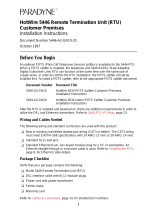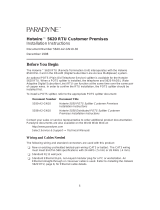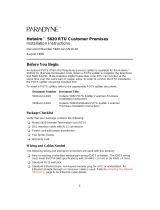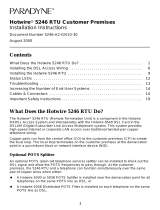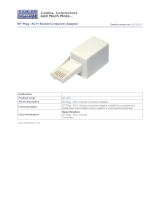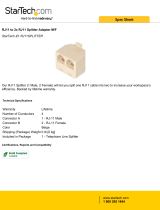
TM
1
HotWire 5246 Remote Termination Unit (RTU)
Customer Premises
Installation Instructions
Document Number 5246-A2-GN10-00
October 1997
Before You Begin
An optional POTS (Plain Old Telephone Service) splitter is available for the 5246 RTU.
When a POTS splitter is installed, the telephone and 5246 RADSL (Rate Adaptive
Digital Subscriber Line) RTU can function at the same time over the same pair of
copper wires. In order to confirm the RTU installation, the POTS splitter should be
installed first. To install a POTS splitter, refer to the appropriate POTS splitter
document:
Document Number Document Title
5030-A2-GN10
HotWire 5030 POTS Splitter Customer Premises
Installation Instructions
5034-A2-GN10
HotWire 5034 Indoor POTS Splitter Customer Premises
Installation Instructions
Wiring and Cables Needed
The following wiring and standard connectors are used with this product:
New or existing unshielded twisted-pair wiring (CAT3 or better). The CAT3 wiring
must meet EIA/TIA-568 specifications with 24 AWG (.5 mm) or 26 AWG (.4 mm).
Standard RJ11 wall jack.
Standard Ethernet 8-pin, non-keyed modular plug for a PC or workstation. An
Ethernet straight-through or crossover cable is used. Refer to
Installing the RTU,
page 8, for Ethernet cable details.
Package Checklist
Verify that your package contains the following:
Model 5246 Remote Termination Unit (RTU)
DSL interface cable with RJ11 modular plugs
Power cord with power transformer
Ferrite choke
Warranty card
Refer to
Cables & Connectors,
page 14, for standard pin numbers.

2
What Does the HotWire RADSL RTU Do?
The 5246 RTU is a component in the DSL Access System. This system provides
high-speed Internet or corporate LAN access over traditional twisted-pair copper
telephone wiring.
DSL Access with a POTS Splitter
Copper pairs run from the central office (CO) to the customer premises (CP) to create
the local loop. The local loop terminates on the customer premises at the demarcation
point in a punchdown block or network interface device (NID).
When a POTS splitter is used at both ends of the local loop, wiring is connected:
H From the demarcation point to the CP POTS splitter, and
H From the demarcation point to the DSL jack.
97-15346-01
Punchdown
Block or NID
DSL
Jack
RTU
New Wiring Connections Existing Wiring (POTS)
Customer Premises (CP)
DSL
Ethernet
Crossover
Cable
Ethernet
Cable
or
Central
Office
(CO)
Demarcation
Point
Local Loop
HUB
CP
POTS
Splitter
DSL - Digital Subscriber Line POTS - Plain Old Telephone Service
NID - Network Interface Device RTU - Remote Termination Unit
POTS
End-user
Systems
Network
Service
Provider
(NSP)
NOTES:
— PC is used to represent any end-user system with an Ethernet connection and
DSL-based service.
— Network Service Provider (NSP) is used to represent any Internet Service
Provider (ISP) or internal LAN administrator.

3
DSL Access without a POTS Splitter
When the 5246 RTU is installed without a POTS splitter, a second telephone wiring pair
is needed for DSL access.
97-15345-01
Punchdown
Block or NID
DSL
Jack
RTU
Customer Premises (CP)
POTS
DSL
Ethernet
Crossover
Cable
Ethernet
Cable
or
Central
Office
(CO)
Demarcation
Point
Local Loop
HUB
New Wiring Connections Existing Wiring (POTS)
End-user
Systems
DSL - Digital Subscriber Line POTS - Plain Old Telephone Service
NID - Network Interface Device RTU - Remote Termination Unit
Network
Service
Provider
(NSP)

4
Installing the DSL Access Wiring
The local loop terminates at the punchdown block or NID. Wiring must be connected
from the customer premises side of the punchdown block or the NID to the DSL jack.
Typically, the punchdown block is installed in commercial locations and the NID is
installed in residential locations.
" Procedure
1. Access the punchdown block or NID. Disconnect the DSL access pair from the
local loop.
!
WARNING:
Do not continue unless the DSL access line from the local loop has been
disconnected at the NID or punchdown block. Refer to
Important Safety
Instructions,
page 16.
A punchdown block is used without a POTS splitter in the following example.
ABCD
DSL
Access
from Local
Loop
Wiring to
DSL Jack
Bridge Clip
Punchdown Block
97-15348
Demarcation Point
Customer Premises

5
Green (T1) and red (R1) are the standard wiring colors used in the next two
illustrations.
In the next example, a NID is used without a POTS splitter. It includes an existing
POTS line and a second pair installed for DSL access. The pair for the POTS line
does not need to be disconnected unless a POTS splitter is going to be installed.
DSL/POTS
Access from
Local Loop
Telephone Network Interface Device (NID)
Ground
Tip
T1
(Green)
Ring
R1
(Red)
97-15439-01
Existing POTS
Wiring to
Telephone
Demarcation Point
Customer Premises
DSL Pair
POTS Pair

6
2. Locate the DSL pair of T1/R1 connectors on the customer premises side of the
NID or punchdown block. Attach the wiring that will be connected to the DSL jack.
Tighten both terminal screws with a flat-blade screwdriver.
DSL/POTS
Access from
Local Loop
Wiring to
DSL Jack
Telephone Network Interface Device (NID)
Ground
Tip
T1
(Green)
Ring
R1
(Red)
97-15438-01
Existing POTS
Wiring to
Telephone
Demarcation Point
Customer Premises
DSL Pair
POTS Pair

7
DSL Jack Installation
The 5246 RTU connects to the local loop via wiring from the demarcation point to an
RJ11 wall jack. The DSL twisted-pair wiring from the local loop terminates at a new or
existing wall jack. It may be necessary to install a standard single RJ11 jack or replace
a single jack with a double RJ11 jack.
The RJ11 6-pin jack uses the center two pins. For pin assignments, refer to
Cables &
Connectors
, page 14.
97-15343-0
1
DSL
RJ11
Jack
Central
Office
Punchdown
Block or NID
Customer Premises
POTS/DSL
Local Loop
Demarcation Point
DSL
Twisted-pair
Wiring
" Procedure
1. Wiring can be run from the punchdown block or NID to a new or existing wall jack.
Match the pair colors on both ends.
2. Label the DSL jack.
97-15300a
RJ11 Wall Jack
or
3. At the demarcation point, reconnect the DSL access wire pair to the local loop.
Refer to
Installing the DSL Access Wiring
, page 4
.
Tighten both terminal screws
with a flat-blade screwdriver.

8
Installing the RTU
Place the 5246 RTU on a flat surface with clearance for the rear connectors.
" Procedure
1. Use the RJ11 6-pin cable for the DSL connection. Insert one end of the cable into
the jack labeled DSL. Insert the other end into the wall jack labeled DSL.
97-15300
DSL
Jack
POWER
ETHERNET
DSL
HotWire RTU

9
2. Use an 8-pin cable for the Ethernet connection. Insert one end of the cable into the
jack labeled ETHERNET.
H Use a straight-through cable and connect the other end to an Ethernet hub, or
97-15303
Ethernet
Hub
Ethernet
Line
POWER
ETHERNET
DSL
HotWire RTU
Ethernet
Cable
H Use an Ethernet crossover cable and connect the other end to a PC with an
Ethernet Network Interface Card (NIC).
97-15303a
Ethernet
Line
POWER
ETHERNET
DSL
PC with Ethernet
Network Interface
Card
HotWire RTU
Ethernet
Crossover
Cable
For RTU cable pin assignments, refer to
Cables & Connectors
, page 14.

496-14952
97-15303a
Ethernet
Line
POWER
ETHERNET
DSL
HotWire RTU
Ferrite
Choke
10
3. Place the supplied ferrite
choke on the Ethernet
cable as closely as possible
to the RTU. Pass the
Ethernet cable through
the ferrite choke twice,
creating a loop as shown.
4. Close the two halves
around the cable and
snap the ferrite choke
shut. Press down on the
plastic latch to secure
the ferrite choke in place
around the cable.
5. Insert the power cord’s round end into the jack labeled POWER. Plug the
transformer into an AC outlet.
The following illustration displays examples of two power supply models.
97-15626
POWER
ETHERNET
DSL
HotWire RTU
Power
Jack
or
Transformer
or
The RTU hardware installation is now complete. When the power cord is installed, the
RTU goes through a power-on self-test.

11
Power-On
When power is applied, the RTU performs self-diagnostics and the PWR LED is on.
The self-diagnostics includes a power-on self-test. During the power-on self-test, all of
the LEDs turn on for one second.
TST
DSL
ETHERNET
ALMPWR
TM
97-15603
Power green
Alarm red
Test yellow
Digital Subscriber Line green
Ethernet Link green
5246
Refer to
Troubleshooting,
page 12, for LED indications requiring action.
Status LEDs
All of the LEDs turn on and off during the power-on self-test. After a successful
self-test, the LEDs should appear as indicated in BOLD in the Condition column below.
LED Condition Status
PWR ON RTU has power.
ALM OFF
ON
No active alarms.
An alarm condition exists.
TST OFF
ON
No active tests.
The TST LED is on during the power-on self-test and
during a test initiated by the NSP.
DSL Blinking
ON
OFF
RTU is establishing the DSL link. The LED blinks on and
off about five times per second.
The DSL link is now active and ready to transmit and
receive data.
The DSL link has not been established.
ETHERNET ON
OFF
The Ethernet 10BaseT connection to the Ethernet hub or
PC is active.
No Ethernet 10BaseT device is detected.

12
Firmware Download
The firmware download feature is available via the Ethernet port for future upgrades.
During a firmware download, the LED displays are:
H ON: ALM, ETHERNET, PWR, and TST
H OFF: DSL
Troubleshooting
LED Symptom Action
All LEDs are on. The RTU is not functional. Contact the NSP.
ALM LED remains
on.
The power-on self-test may have failed. Unplug the unit and
reapply power. If the alarm LED is still on, contact the NSP.
ALM and TST
LEDs remain on.
Refer to
Firmware Download.
If the LEDs remain on after five
minutes, contact the NSP.
DSL LED is off.
Verify that the DSL cable is securely installed on both ends.
If the RTU is not in firmware download mode, unplug the RTU
and reapply power. If problem continues, contact the NSP
DSL LED continues
to blink after the
power-on self-test.
The RTU is attempting to establish the DSL link. If the DSL
LED continues to blink for more than five minutes, contact the
NSP.
DSL LED is on and
there is no data
transmission.
The DSL link has been established but there is no data
transmission. First, verify the Ethernet connection. If the
problem persists, contact the NSP.
DSL and Ethernet
LEDs are on and
there is no data
transmission.
The DSL link and the Ethernet link have been established. If
the problem continues, contact the NSP.
Ethernet LED is off.
Verify that:
H The Ethernet 10BaseT cable is securely installed at both
ends, and
H At least one PC is connected and powered on.
Verify that the correct straight-through or crossover cable is
installed. Refer to
Cables & Connectors,
page 14.

13
LED Symptom Action
PWR LED is off.
Check that the power cord is securely installed on both ends.
If no LEDs are on, the power supply may be defective. Try a
different outlet to test the power supply. If problem persists,
contact the NSP.
If other LEDs are on, the PWR LED may be burned out. Unplug
the unit and reapply power; watch all LEDs during the
power-on self-test to verify that the PWR LED is functioning.
TST LED is on. A test initiated by the NSP may be active. Wait five minutes. If
the TST LED does not go off, contact the NSP.
Increasing the Number of End-User Systems
A single PC is attached to the 5246 RTU by using an Ethernet crossover cable. To
increase the number of PCs, connect all PCs to an Ethernet hub using a
straight-through cable.
The 5246 RTU can support up to 32 PCs. Verify any planned changes with the NSP.

97-15304
6-Pin
RJ11 Plug
DSL Line
Pin #1
Pin #6
14
Cables & Connectors
Use standard twisted-pair CAT3 or better cables.
This section is reference information.
H The DSL interface connector uses a 6-pin, non-keyed modular plug.
RJ11 6-Pin Connector
Pin # Function
1 & 2 Not used
3 DSL Ring
4 DSL Tip
5 & 6 Not used

97-15305
8-Pin
Plug
Ethernet Cable
Pin #1
Pin #8
15
H The Ethernet interface connector uses an 8-pin, non-keyed modular plug.
— To connect to an Ethernet hub, use the straight-through connection.
8-Pin Straight-Through Connection
Pin # Function
1 10BaseT TX D+
2 10BaseT TX D–
3 10BaseT RX D+
4 & 5 Not used
6 10BaseT RX D–
7 & 8 Not used
— To connect the RTU directly to
a PC with an Ethernet NIC card,
use an Ethernet crossover cable.
10BaseT TX D+
10BaseT TX D
10BaseT RX D+
Not Used
Not Used
10BaseT RX D
Not Used
Not Used
1
2
3
4
5
6
7
8
1
2
3
4
5
6
7
8
10BaseT TX D+
10BaseT TX D
10BaseT RX D+
Not Used
Not Used
10BaseT RX D
Not Used
Not Used
Function Pin # FunctionPin #
8-Pin Ethernet Crossover Cable
97-15316

16
Model 5246 RTU Technical Specifications
Item Specification
*
Height x Width x Depth
1.35″ x 6.00″ x 8.75″ (3.43 cm x 15.35 cm x 22.23 cm)
Weight 1 lb. 1 oz. (0.48 kg)
Power
Class 2 Transformer normal
service input voltage range
Input: 100 Vac, 50 Hz; 120 Vac, 60 Hz; or
230 Vac, 50/60 Hz
Output: 15 Vdc nominal (+
10%), minimum 0.6A
Approvals
FCC Part 15
CISPR 22
Safety Certifications
Class B Subpart B digital device
Class B
Refer to equipment’s label for approvals on product.
Physical Environment
Operating temperature
Storage temperature
Relative humidity
Shock and vibration
32°F to 104°F (0°C to 40°C)
–4°F to 158°F (–20°C to 70°C)
5% to 95% (noncondensing)
Withstands normal shipping and handling
Heat Dissipation 40.9 Btu/hr. (max.) at nominal input voltage
Interface Connectors
DSL Interface
Ethernet Type II Frame
RJ11 6-pin
10BaseT 8-pin
*
Technical Specifications subject to change without notification.
Important Safety Instructions
1. Read and follow all warning notices and instructions marked on the product or
included in the manual.
2. Slots and openings in the cabinet are provided for ventilation. To ensure reliable
operation of the product and to protect it from overheating, these slots and
openings must not be blocked or covered.
3. Do not allow anything to rest on the power cord and do not locate the product
where persons will walk on the power cord.
4. Do not attempt to service this product yourself, as opening or removing covers
may expose you to dangerous high voltage points or other risks. Refer all servicing
to qualified service personnel.

17
5. General purpose cables are used with this product for connection to the network.
Special cables, which may be required by the regulatory inspection authority for
the installation site, are the responsibility of the customer. Use a UL Listed, CSA
certified, minimum No. 24 AWG line cord for connection to the Digital Subscriber
Line (DSL) network.
6. When installed in the final configuration, the product must comply with the
applicable Safety Standards and regulatory requirements of the country in which it
is installed. If necessary, consult with the appropriate regulatory agencies and
inspection authorities to ensure compliance.
7. A rare phenomenon can create a voltage potential between the earth grounds of
two or more buildings. If products installed in separate buildings are
interconnected, the voltage potential may cause a hazardous condition. Consult a
qualified electrical consultant to determine whether or not this phenomenon exists
and, if necessary, implement corrective action prior to interconnecting the products.
8. Input power to this product must be provided by one of the following: (1) a UL
Listed/CSA certified power source with a Class 2 or Limited Power Source (LPS)
output for use in North America, or (2) a certified transformer, with a Safety Extra
Low Voltage (SELV) output having a maximum 240 VA available, for use in the
country of installation.
9. In addition, since the equipment is to be used with telecommunications circuits,
take the following precautions:
— Never install telephone wiring during a lightning storm.
— Never install telephone jacks in wet locations unless the jack is specifically
designed for wet locations.
— Never touch uninsulated telephone wires or terminals unless the telephone
line has been disconnected at the network interface.
— Use caution when installing or modifying telephone lines.
— Avoid using a telephone (other than a cordless type) during an electrical
storm. There may be a remote risk of electric shock from lightning.
— Do not use the telephone to report a gas leak in the vicinity of the leak.
CE Marking
When the product is marked with the CE mark on the equipment label, this
demonstrates full compliance with the following European Directives:
H Directive 73/23/EEC – Council Directive of 19 February 1973 on the harmonization
of the laws of the member states relating to electrical equipment designed for use
within states relating to electrical equipment designed for use within certain voltage
limits, as amended by Directive 93/68/EEC.
H Directive 89/336/EEC – Council Directive of 3 May 1989 on the approximation of
the laws of the member states relating to Electro-Magnetic Compatibility (EMC), as
amended by Directive 93/68/EEC.

18
Japan
Class 2 ITE
This is a Class 2 product based on the standard of the Voluntary Control Council for
Interference from Information Technology Equipment (VCCI). If this is used near a radio
or television receiver in a domestic environment, it may cause radio interference. Install
and use the equipment according to the instruction manual.
Declaration of Conformity
This Declaration of Conformity is made by Paradyne Corporation pursuant to Parts 2
and 15 of the Federal Communications Commission’s Rules. This compliance
information statement pertains to the following products:
Trade Name: HotWire
Model Number: 5246-A1-200
This device complies with Part 15 of the FCC Rules. Operation is subject to the
following two conditions: (1) this device may not cause harmful interference, and (2)
this device must accept any interference received, including interference that may
cause undesired operation.
The name, address, and telephone number of the responsible party is given below:
Paradyne Corporation
8545 126th Avenue North
Largo, FL 33773-1502
Phone: (813) 530-2000
The authority to operate this equipment is conditioned by the requirement that no
modifications will be made to the equipment unless the changes or modifications are
expressly approved by Paradyne Corporation.
In order to maintain compliance with Part 15, FCC rules, the clamp-on ferrite choke
must be installed on the Ethernet cable in accordance with the installation instructions.

19
Canada
EMI Warnings
!
WARNING:
To Users of Digital Apparatus in Canada:
This Class B digital apparatus meets all requirements of the Canadian
interference-causing equipment regulations.
Cet appareil numérique de la classe B respecte toutes les exigences du
règlement sur le matérial brouilleur du Canada.
Notice to Users of the Canadian Telephone Network
The Industry Canada label identifies certified equipment. This certification means that
the equipment meets telecommunications network protective, operational and safety
requirements as prescribed in the appropriate Terminal Equipment Technical
Requirements document(s). The Department does not guarantee the equipment will
operate to the user’s satisfaction.
Before installing this equipment, users should ensure that it is permissible to be
connected to the facilities of the local telecommunications company. The equipment
must also be installed using an acceptable method of connection. The customer should
be aware that compliance with the above conditions may not prevent degradation of
service in some situations.
Repairs to certified equipment should be coordinated by a representative designated by
the supplier. Any repairs or alterations made by the user to this equipment, or
equipment malfunctions, may give the telecommunications company cause to request
to disconnect the equipment.
Users should ensure for their own protection that the electrical ground connections of
the power utility, telephone lines and internal metallic water pipe system, if present, are
connected together. This precaution may be particularly important in rural areas.
CAUTION:
Users should not attempt to make such connections themselves, but should
contact the appropriate electric inspection authority, or electrician, as
appropriate.
The Ringer Equivalence Number (REN) assigned to each terminal device provides an
indication of the maximum number of terminals allowed to be connected to a telephone
interface. The termination on an interface may consist of any combination of devices
subject only to the requirement that the sum of the Ringer Equivalence Numbers of all
the devices does not exceed 5.
If your equipment is in need of repair, refer to the next section.

20
Warranty, Sales, and Service Information
Contact your sales or service representative directly for any help needed. For additional
information concerning warranty, sales, service, repair, installation, documentation, or
training, use one of the following methods:
H Via the Internet: Visit the Paradyne World Wide Web site at
http://www.paradyne.com
H Via Telephone: Call our automated call system to receive current information via
fax or to speak with a company representative.
— Within the U.S.A., call 1-800-870-2221
— International, call 813-530-2340.
*5246–A2–GN10–00*
/

